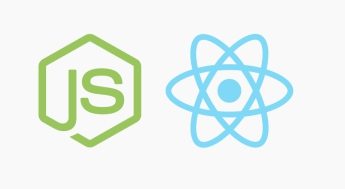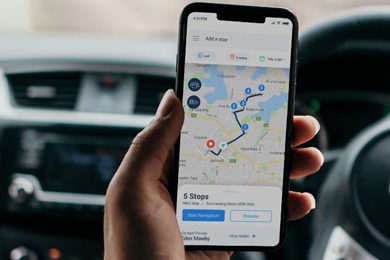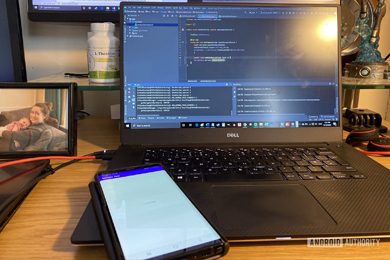This plan includes
- Limited free courses access
- Play & Pause Course Videos
- Video Recorded Lectures
- Learn on Mobile/PC/Tablet
- Quizzes and Real Projects
- Lifetime Course Certificate
- Email & Chat Support
What you'll learn?
- Installing React Native and setting up Android emulator and iOS simulator
- Core React Native concepts, such as working with components, state, and props
- Styling and how to layout items using Flexbox
- How to work with images, fonts, and Icons in React Native
- Set up Navigation using React Navigation
- Implement the three types of navigation commonly found in mobile apps: Stack, Tabs, and Drawer
- State Management with Redux
- Understand the basic concepts of Node
- Build RESTful APIs using Express Framework
- Add validations using Express-validator
- Working with a database system (MongoDB)
- Implement Authentication using JWT
- Deploying backend to Heroku
- Tips on how to deploy the frontend to the various App Stores
Course Overview
Becoming a full-stack developer has a lot of benefits and full-stack engineering has gained a lot of popularity in the past few years. Also, the importance of mobile apps can not be overemphasized. It is one of the best ways to connect with users. Throughout the course, I will show you best practices and how to effectively make use of documentations.
In this course, you will learn how to build four mobile apps
-
Todo App - React Native
-
News App - React Native, React Navigation, Redux.
-
Home Listing App - React Native, React Navigation, Redux, Node/Express, MongoDB
-
Authentication System App - React Native, React Navigation, Redux, Node/Express, MongoDB
A detailed list of what you'll learn
-
Installing React Native and setting up Android emulator and iOS simulator
-
Core React Native concepts, such as working with components, state, and props
-
Styling and how to layout items using Flexbox
-
How to work with images, fonts, and Icons in React Native
-
Set up Navigation using React Navigation
-
Implement the three types of navigation commonly found in mobile apps: Stack, Tabs, and Drawer
-
State Management with Redux
-
Understand the basic concepts of Node
-
Build RESTful APIs using Express Framework
-
Add validations using Express-validator
-
Working with a database system (MongoDB)
-
Implement Authentication using JWT
-
Deploying backend to Heroku
-
Tips on how to deploy the frontend to the various App Stores
Pre-requisites
- Basic knowledge of Javascript and React. You don't have to be an expert
Target Audience
- Web developers interested in building full-stack mobile apps using React Native powered by Express Framework backend
Curriculum 113 Lectures 14:30:34
Section 1 : Getting Started
- Lecture 2 :
- Installing React Native
- Lecture 3 :
- Setting up Android Emulator
- Lecture 4 :
- Setting up iOS Simulator
- Lecture 5 :
- Course Outline
Section 2 : React Native Basic Concepts
- Lecture 1 :
- Section Introduction
- Lecture 2 :
- Structure of a React Native App
- Lecture 3 :
- React Native core components
- Lecture 4 :
- Styling React Native components
- Lecture 5 :
- Working with State
- Lecture 6 :
- Rendering Items
- Lecture 7 :
- Working with Props
Section 3 : Styling in React Native
- Lecture 1 :
- Section Introduction
- Lecture 2 :
- Layout with Flexbox
- Lecture 3 :
- Styling based on platform
- Lecture 4 :
- Creating the Card component
- Lecture 5 :
- Working with Images
- Lecture 6 :
- Using custom fonts
- Lecture 7 :
- Adding Icons
Section 4 : Navigation in React Native
- Lecture 1 :
- Section Introduction
- Lecture 2 :
- Creating the required screens
- Lecture 3 :
- Setting up React Navigation
- Lecture 4 :
- Moving between screens
- Lecture 5 :
- Adding a tabs-bar navigation
- Lecture 6 :
- Working with drawer navigation
Section 5 : Site Management with Redux
- Lecture 1 :
- Section Introduction
- Lecture 2 :
- What is Redux?
- Lecture 3 :
- Setting up Redux store
- Lecture 4 :
- Redux Reducers
- Lecture 5 :
- Redux Actions
- Lecture 6 :
- Making Http requests
- Lecture 7 :
- Dispatching Redux actions
- Lecture 8 :
- Displaying Items using FlatList
- Lecture 9 :
- Fixing the FlatList display
- Lecture 10 :
- React Native Debugger
- Lecture 11 :
- Add Items to favorites
- Lecture 12 :
- Dispatching Add to favorites action
- Lecture 13 :
- Toggling the Fav Icon
- Lecture 14 :
- Setting up the News Details screen
Section 6 : Node.js Basic Concepts
- Lecture 1 :
- Section Introduction
- Lecture 2 :
- Executing node scripts
- Lecture 3 :
- Node Module System
- Lecture 4 :
- Node File System
- Lecture 5 :
- Node Event module
- Lecture 6 :
- Creating a web server using the HTTP module
- Lecture 7 :
- Using NPM packages
Section 7 : REST API using Express.js
- Lecture 1 :
- Section Introduction
- Lecture 2 :
- Building a web server using Express
- Lecture 3 :
- Using env variables
- Lecture 4 :
- Testing endpoints using Postman
- Lecture 5 :
- Route parameters
- Lecture 6 :
- Create a resource
- Lecture 7 :
- Update a resource
- Lecture 8 :
- Delete a resource
Section 8 : Working with MongoDB
- Lecture 1 :
- Section Introduction
- Lecture 2 :
- Setting up MongoDB
- Lecture 3 :
- Connecting to MongoDB using mongoose
- Lecture 4 :
- MongoDB Compass
- Lecture 5 :
- Creating a schema
- Lecture 6 :
- Creating a model
- Lecture 7 :
- Creating a house listing data
- Lecture 8 :
- Adding validation
- Lecture 9 :
- Fetching data
- Lecture 10 :
- Updating data
- Lecture 11 :
- Deleting data
Section 9 : Home Listing App [React Native]
- Lecture 1 :
- Section Introduction
- Lecture 2 :
- Setting up the react native app
- Lecture 3 :
- Setting up navigation
- Lecture 4 :
- Adding Tabs bar Icons
- Lecture 5 :
- Creating the card component
- Lecture 6 :
- Adding a floating action button
- Lecture 7 :
- Moving between screens
- Lecture 8 :
- Building out the Add Home screen
- Lecture 9 :
- Building out the home details screen
- Lecture 10 :
- Adding Redux to our app
- Lecture 11 :
- Adding Redux action and reducer
- Lecture 12 :
- Fetching the house listing data
- Lecture 13 :
- Displaying the data on the card
- Lecture 14 :
- Displaying the data on the homeDetails screen
- Lecture 15 :
- Create form using formik
- Lecture 16 :
- Adding validation using yup
- Lecture 17 :
- Create home action and reducer
- Lecture 18 :
- Dispatching the create home action
- Lecture 19 :
- Displaying a loading Icon
Section 10 : Authentication System [Express.js
- Lecture 1 :
- Section Introduction
- Lecture 2 :
- Setting up the express app
- Lecture 3 :
- Adding a database system
- Lecture 4 :
- Registering a new user
- Lecture 5 :
- Adding validation
- Lecture 6 :
- Hashing password
- Lecture 7 :
- Login route
- Lecture 8 :
- Set up JWT
- Lecture 9 :
- Protecting a route
Section 11 : Authentication System [React Native]
- Lecture 1 :
- Section Introduction
- Lecture 2 :
- Setting up the react native app
- Lecture 3 :
- Adding navigation to the auth system
- Lecture 4 :
- Building out the login and register screens I
- Lecture 5 :
- Building out the Login and Register screens II
- Lecture 6 :
- Adding validation to the form
- Lecture 7 :
- Some changes on the backend
- Lecture 8 :
- Setup Redux
- Lecture 9 :
- Add actions and reducers
- Lecture 10 :
- Making a POST request to register a new user
- Lecture 11 :
- Making a POST request to login a user
- Lecture 12 :
- Displaying error messages from the backend
- Lecture 13 :
- Storing tokens using AsyncStorage
- Lecture 14 :
- Fetching tokens
- Lecture 15 :
- Decoding tokens using jwt-decode
Section 12 : Deployment
- Lecture 1 :
- Section Introduction
- Lecture 2 :
- Preparing the backend for deployment
- Lecture 3 :
- Deploying the backend to Heroku
- Lecture 4 :
- Preparing the frontend for deployment
- Lecture 5 :
- Hints on deploying the react native app
Our learners work at
Frequently Asked Questions
How do i access the course after purchase?
It's simple. When you sign up, you'll immediately have unlimited viewing of thousands of expert courses, paths to guide your learning, tools to measure your skills and hands-on resources like exercise files. There’s no limit on what you can learn and you can cancel at any time.Are these video based online self-learning courses?
Yes. All of the courses comes with online video based lectures created by certified instructors. Instructors have crafted these courses with a blend of high quality interactive videos, lectures, quizzes & real world projects to give you an indepth knowledge about the topic.Can i play & pause the course as per my convenience?
Yes absolutely & thats one of the advantage of self-paced courses. You can anytime pause or resume the course & come back & forth from one lecture to another lecture, play the videos mulitple times & so on.How do i contact the instructor for any doubts or questions?
Most of these courses have general questions & answers already covered within the course lectures. However, if you need any further help from the instructor, you can use the inbuilt Chat with Instructor option to send a message to an instructor & they will reply you within 24 hours. You can ask as many questions as you want.Do i need a pc to access the course or can i do it on mobile & tablet as well?
Brilliant question? Isn't it? You can access the courses on any device like PC, Mobile, Tablet & even on a smart tv. For mobile & a tablet you can download the Learnfly android or an iOS app. If mobile app is not available in your country, you can access the course directly by visting our website, its fully mobile friendly.Do i get any certificate for the courses?
Yes. Once you complete any course on our platform along with provided assessments by the instructor, you will be eligble to get certificate of course completion.
For how long can i access my course on the platform?
You require an active subscription to access courses on our platform. If your subscription is active, you can access any course on our platform with no restrictions.Is there any free trial?
Currently, we do not offer any free trial.Can i cancel anytime?
Yes, you can cancel your subscription at any time. Your subscription will auto-renew until you cancel, but why would you want to?
Instructor

8324 Course Views
1 Courses



 Tech & IT
Tech & IT
 Business
Business
 Coding & Developer
Coding & Developer
 Finance & Accounting
Finance & Accounting
 Academics
Academics
 Office Applications
Office Applications
 Art & Design
Art & Design
 Marketing
Marketing
 Health & Wellness
Health & Wellness
 Sounds & Music
Sounds & Music
 Lifestyle
Lifestyle
 Photography
Photography

















